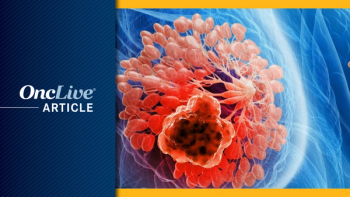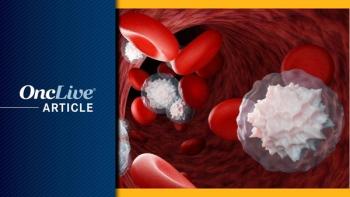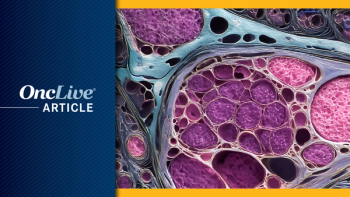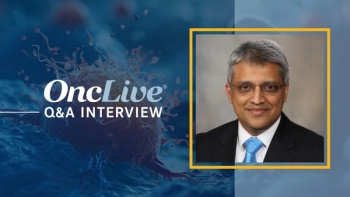
Supplements and Featured Publications
- IRAK4 Inhibition Makes a Splash in B-Cell Malignancies
- Volume 1
- Issue 1
Emavusertib Demonstrates Safety, Early Antitumor Activity in Select Patients With FLT3-Mutant R/R AML
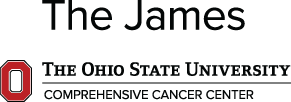
Alice Mims, MD, discusses the toxicity profile and initial efficacy of emavusertib in heavily pretreated, FLT3-mutated relapsed/refractory AML.
The IRAK-4 and FLT-3 inhibitor emavusertib (previously CA-4948) demonstrated a favorable safety profile and early signs of antitumor activity in heavily pretreated patients with relapsed or refractory acute myeloid leukemia (AML) harboring FLT3 mutations, some of whom also expressed the spliceosome mutations U2AF1 and SF3B1, according to Alice Mims, MD.
Findings from the FLT3-mutated AML cohort (n = 10) in the phase 1/2a TakeAim Leukemia trial (NCT04278768) were presented at the
“It’s exciting that we’re starting to see responses [with emavusertib monotherapy] in these populations—especially as the agent has dual activity against different targets,” Mims, who is a medical oncologist, associate professor in the Division of Hematology, and director of Acute Leukemia Clinical Research at The Ohio State University Comprehensive Cancer Center—James, in Columbus, told OncLive®. “Seeing that there may be a potential targeted agent for patients with spliceosome mutations, when there’s no [drug specifically approved] for that population right now, is [also] exciting.”
The phase 2a dose-expansion portion of the trial is ongoing and is currently evaluating the recommended phase 2 dose (RP2D) of twice-daily 300 mg of emavusertib in patients with 2 or more prior lines of therapy. Preliminary analysis of 7 patients with FLT3-mutated AML demonstrated 2 achieved complete responses (CR), 2 achieved stable disease, 1 achieved a morphologic leukemia-free state, and 1 experienced disease progression with the agent.
In the interview, Mims discussed the rationale for specifically evaluating emavusertib in patients with AML and either FLT3 or specific spliceosome mutations, reported safety and early efficacy findings from the dose-escalation/dose-expansion portions of the phase 1 study, and highlighted future research avenues for assessing the potential benefit of emavusertib in combination regimens or for patients harboring other spliceosome mutations.
OncLive: What is the mechanism of action of emavusertib, and why was this agent specifically evaluated in patients with FLT3-mutant AML and high-risk myelodysplastic syndrome (MDS)?
Mims: Emavusertib is a small molecule kinase inhibitor, and it is multitargeted. It showed preclinical activity against IRAK4 and FLT3, as well as Cdc2-like kinases, which are [targets] of interest these days.
The highest level of interest [in this agent] is for patients with AML [harboring] FLT3 mutations or the specific spliceosome mutations U2AF1 and SF3B1. The study is also looking at patients with high-risk MDS, specifically in those with the same spliceosome mutations. The reason [for this] is that IRAK4 is upregulated during anti-FLT3 or other cytotoxic therapies, so it could drive resistance pathways for patients who are on FLT3 inhibitors. It’s important to look at that and [see if emavusertib] is something that could be used initially in combination, as opposed to current FLT3 inhibitors [alone]. Patients with spliceosome mutations have an excess of IRAK4 ligand, and that enhances the toll-like receptor pathway, which is frequently dysregulated in AML.
What was the design of the phase 1/2 study? What patients were eligible for enrollment?
This is a phase 1 dose-escalation, phase 2 dose-expansion study. When the study first started, it was for all-comers, [comprising] patients 18 years of age and older who had relapsed/refractory AML or higher-risk MDS that was not responsive to hypomethylating agents [HMAs].
Over time, the study was amended to just look at those specific AML populations mentioned above, as well as the MDS populations. [The study was] also limited to patients who had not received more than 2 lines of prior therapy. For the AML patients with FLT3 mutations, [investigators] wanted to be sure that they had previously received a FLT3 inhibitor, since a few of those are FDA approved in different settings.
What were the primary end points of the study?
For the phase 1 portion of the study, [the primary end points were] safety and tolerability in patient populations, [as well as] identifying the maximum tolerated dose and RP2D. The primary end point for the dose-expansion phase 2a portion is anticancer activity in those specific AML and MDS populations. For the AML [population], [investigators are] specifically looking at the proportion of patients who achieve a CR or a CR with hematologic improvement. For the high-risk MDS population, they’re looking at overall response rate, which is defined as a CR after partial remission.
What initial efficacy findings were reported from the study at the 2023 ASH Annual Meeting?
[In the presentation, investigators] focused on responses in patients with relapsed/refractory AML and FLT3 mutations. [Eleven] patients were included in the dose-escalation portion, [9 of whom were response evaluable]. Nine of the patients had FLT3-ITD mutations, and 1 had a FLT3-TKD mutation. Two of the patients with an FLT3-ITD mutation had a concurrent U2AF1 mutation, and the 1 patient with a FLT3-TKD mutation also had an SF3B1 mutation. These patients had been heavily pretreated.
[Investigators] saw reductions in blast count for those patients. Enrollment in the dose expansion for the phase 2a portion of the study has started, and they’re moving forward with a 300-mg twice-a-day oral dose. They’ve looked at patients with FLT3 mutations; 2 of these patients have [achieved] CR, and 1 has [achieved] a morphologic leukemia-free state. The interesting thing to note is that the patients with the FLT3-ITD mutations who [achieved] CRs also had undetectable status of their FLT3-ITD mutations and minimal residual disease–negative status.
What safety data were reported?
The drug seems to be overall well tolerated. There have not been any DLTs in those 10 patients presented and no dose-limiting myelosuppression was noted. TRAEs have been seen. Two studies are currently looking at this agent in different populations, and [the most common] adverse effects [AEs] occurring in more than 10% of the patients treated would be creatine phosphokinase [CPK] increases, nausea, dizziness, fatigue, diarrhea, and alanine transaminase level increases. One AE of special interest is rhabdomyolysis. Evidence of this [was seen] in preclinical animal models, so they’re following [this AE] along with CPK levels. From my understanding, there have not been any clinically significant rhabdomyolysis AEs reported in the study thus far. There may be some laboratory CPK elevation, but nothing that was not reversible for the patient.
Based on these data, what next steps are planned for research with emavusertib within the field of hematologic malignancies?
[Future research] could look at [whether] combination regimens [with] emavusertib [and] either intensive induction, triplet therapy, or venetoclax [Venclexta] and an HMA could be tolerated. Looking at it in the up-front setting would be exciting, as well.
There’s also some discussion and interest from investigators [in evaluating this agent in patients with] other spliceosome mutations that are not included [in the study], and [identifying whether] those could also be part of the eligibility criteria. We’ll see whether that moves forward or not. It’ll be important to see how things develop as the study moves forward in the phase 2 dose expansion.
Reference
Winer ES, Verma A, Groepper S, et al. Preliminary safety and efficacy of emavusertib (CA-4948) in acute myeloid leukemia patients with FLT3 mutation. Blood. 2023;142(suppl 1):2924. doi:10.1182/blood-2023-190007


